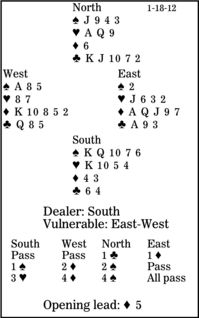Bridge column, January 18: If you'll go there, get there quickly

The first five calls of the auction were impeccable. Then we get to West's two-diamond raise. That was much too cautious. If West thought game was makable his way, he should have cue-bid two spades to show a maximum pass with diamond support. But if he judged game to be unlikely, he should have applied the Law of Total Tricks and jumped to four diamonds. With a combined 10-card fit, bid to the 10-trick level.
North had a comfortable two-and-a-half-spade rebid, but chose two spades because of his low point-count. Then South judged well to make a game-try.
Now West showed the error of his earlier way. If he was willing to bid four diamonds, he should have done it immediately, not given his opponents a fielder's choice of doubling or bidding four spades.
In four spades, declarer has to guess clubs. If the diamond ace is a true card, West is marked with the diamond king and has produced the spade ace; he cannot also have the club ace. So South should play a club to dummy's 10.
True, East might have falsecarded at trick one, given dummy's singleton, but don't make a habit of assuming the defenders are being devious.
** ** **
COPYRIGHT 2012, UNITED FEATURE SYNDICATE
DISTRIBUTED BY UNIVERSAL UCLICK FOR UFS

